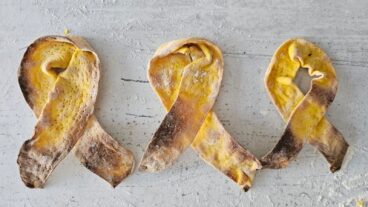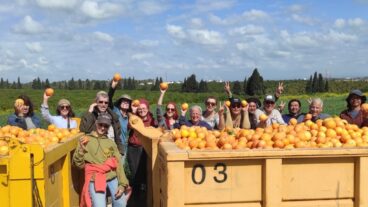A science-based approach underlies dairy farming in Israel. In fact most Israeli farmers are more likely to make their rounds, carrying a palm pilot than a bucket.Israeli scientists have discovered a gene that determines the concentration of protein found in cow’s milk, and plan to use that finding to spur the production of higher-protein milk in dairy herds all over the world.
A team, headed by Dr. Micha Ron of the Volcani Research Institute, found that a cattle gene called ABCG2 is responsible for the amount of protein found in milk, and that one version of that gene boosts protein concentration by 10 percent.
The researchers first discovered the mutation in two Israeli Holstein bulls, one of them, named Goliath. The study, soon to be published in the scientific journal Genome Research, was conducted in collaboration with scientists from the University of Illinois.
It marks the first time a gene responsible for protein content in cow milk has been found – and only the second discovery of a gene linked to cow milk production. (The first, identified recently by a German-Belgian team, affects the fat content of milk.)
“We’ve been searching for this gene for 10 years,” said Ron, a molecular geneticist at the government Agricultural Research Organization of the Volcani Institute, who presented the findings at Israel’s annual Cattle Research Conference in Jerusalem earlier this month.
Israeli cows rank #1 in the world in terms of average milk production, as well as the protein and fat content of their milk – achievements that are due largely to the science-based approach that underlies dairy farming in Israel.
In that respect, the discovery of the new gene won’t make much difference in Israel where dairy cows – all of the Holstein variety – already produce high-protein milk.
“The percentage of cows in Israel with the high protein gene is quite high,” said Ron, “which illustrates that the classical breeding techniques used here have worked well; the best bulls have been chosen as sires.
“But now we have the opportunity to endow other cattle breeds in the rest of the world with the ability to produce high-protein milk,” explained Ron, who has already received 1600 DNA samples from all 38 cattle breeds in the world – sent to him by German researcher Prof. Georg Erhardt, who collects such samples. Ron is about to begin testing the samples to determine the frequency of the protein-boosting mutation in these other breeds.
Through classical breeding techniques, protein content of milk (or any other trait) can be increased at an optimum rate of one percent a year – meaning it would take at least a decade to augment it by 10%. Now farmers will be able to select a bull who bears the gene variant, and use him to impregnate [through artificial insemination] thousands of cows. A simple blood test can then determine which of the new-born offspring have the high-protein version of the gene, enabling farmers to pick out the ‘stars’ – for both milk production and siring.
“It’s a short-cut, particularly for developing countries, which will enable them to boost the genetic profile of herds and enrich the nutritional value of milk,” Ron told ISRAEL21c.
He and his team discovered the gene on chromosome 6, after searching methodically for genetic markers in ten Israeli Holstein bulls and their 1000 female offspring. They eventually found the protein-boosting mutation on two sires: ‘Goliath’ and ‘Mefi’ – and confirmed the results by studying DNA samples from American cattle (also of the Holstein variety) provided by collaborators from the University of Illinois.
While the average cow produces milk containing 3 percent protein, those with the mutation produce 3.3% – a significant difference when dealing with thousands of pounds of milk per cow per year.
“The finding will also have a major economic impact on cheese-makers, who require mainly protein,” said Ron, whose team included Miri Cohen-Tzinder, Dr. Eyal Seroussi, Dr. Moshe Shani and Dr. Joel I. Weller. The University of Illinois team was headed by Prof. Harris Lewin.
Ron and his team beat out three other international research teams – from the US, Germany and Norway – who were all trying to locate the same gene over the last decade. The Israeli scientist is now trying to track down another gene that influences fertility among cows.
Even without the benefit of this latest research, Israeli dairy cows are the most productive in the world, averaging 25,400 pounds of milk per cow per year, compared to approximately 18,800 pounds achieved by the American runners-up, 17,000 by Canadian cows, 13,800 by European Union ones, and 10,200 pounds by Australian cattle.
The science-based, industrial approach that has led to these achievements was adopted in part to compensate for an acute shortage of grazing land and water in Israel. Instead, dairy farming in Israel is intensive, relying on a total-ration feed mix, advanced automated milking equipment, and computer-based management systems – all developed in Israel – and many sold worldwide.
In addition, ‘computerized matchmaking’ has been taken to new levels of sophistication in the country’s dairy industry which has developed a comprehensive data base.
Virtually every one of the 110,000 dairy cows in Israel is listed in a national computerized data base, which is updated daily and published annually as ‘The Herd Book.’
This data base contains all the vital statistics of every cow, from name, size, and milk production rates, to ovulation cycle and progeny. There are also lists of the ‘top performers’ – this year’s ‘Milk Queen’, for instance, is a bovine named ‘Shkufit’, who produced a whopping 42,916 pounds of milk, and is described by her owner, as “a very intelligent cow.”
Israeli cows are artificially inseminated with progeny-tested semen, with the Herd Book serving as a match-making aid.
“When a farmer wants ‘a mate’ for his cow, he’ll consult with us,” says David Ben-Uziel of the Israel Cattle Breeders Association which developed and maintains the data base.
“We can analyze the profile of a particular cow or an entire herd and see what its weaknesses are: low protein in milk, bad udders, weak legs. Then we can use this information to select the most suitable sire to improve the characteristics of the offspring,” said Uziel.
The data base is also accessible to dairy farmers who use it to solve day-to-day problems in their herds. In fact today, most Israeli farmers are more likely to make their rounds, carrying a palm pilot than a bucket.
“You want to know what’s wrong with Rivka, your prize cow, you check the data base using your Palm,” explains Israel Cattle Breeders Association general manager Meir Brawn.
“Any farmer in the country can get an on-line answer to any question about a particular cow. Farmers can compare today’s output with yesterday’s. They can also be alerted when each cow is ovulating – which occurs for only a day-and-a half. They could easily miss the opportunity to inseminate a cow if they did not have this computerized system,” says Brawn.
He noted that numerous companies abroad have expressed interest in acquiring the Israeli system which he maintains is the “most comprehensive and sophisticated in the world.”












